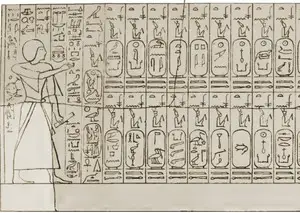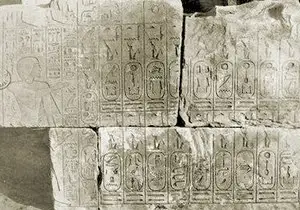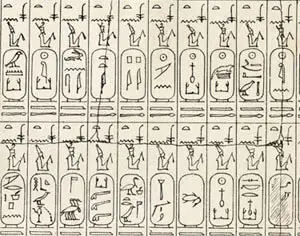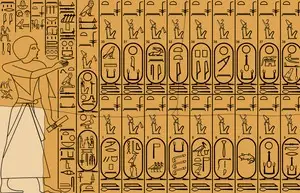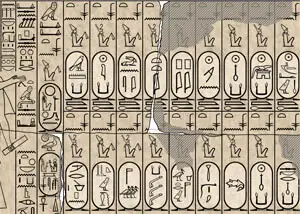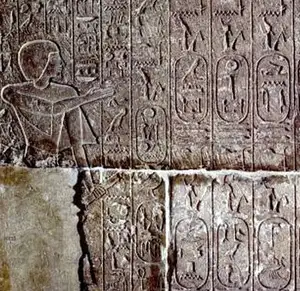The Saqqara Canon (a.k.a. Saqqara Tablet) contains a list of Egyptian pharaohs. Mariette wrote of the discovery to his patron Vicomte de Rougé in March of 1860, but the list was not published until 1864.
It was inscribed on a wall in a funerary shrine above the tomb of a lector-priest by the name Tjunery (), who lived during the reign of Ramesses II. The location of the tomb is lost, but supposedly south of Djoser's step pyramid, close to the pyramid of Unas, between the Monastery and Sekhemkhet’s enclosure.
The inscription originally listed 58 kings in two rows of 29 kings each, in reverse chronological order, starting with Ramesses II, going backwards to Adjib. It was discovered in eight parts, with a section missing, which was searched for but never found. It is assigned inventory number JE 11335 (CG 34516), and is on display in Hall 9 at the Egyptian Museum in Cairo.
It was written in the tradition of Lower Egypt, i.e. preferring honored ancestors with a strong affinity in Lower Egypt. The purpose of the list was to show celebrated "ancestors," and was not meant to be a complete chronological list, apparent by the exclusion of Hatshepsut and the heretic Amarna pharaohs.
Cartouche 39 was recorded by Mariette in 1864 containing the name Menkaura, but this is the only attestation for this. In all subsequent line drawings, the cartouche is drawn as unreadable, so the reading cannot be trusted, it was likely added by Mariette.

Content of the list
Curiously, the New Kingdom kinglists have differing numbers of kings for the Fourth Dynasty. Abydos holds six kings (20-25), Saqqara nine (43-35) and the Royal Canon of Turin eight (4.9-16). At some point, the records of the Fourth Dynasty suffered damage that resulted in incompletely preserved archives for posterity. Centuries later, scribes accessing the archives for information about the ancient kings either failed to realize that the records were incomplete, or misinterpreted the contents. The variation in the three king lists is puzzling.
The justice of Ra is powerful, chosen of Ra
Reconstructed partial name
based on known predecessors.
Eternal is the Truth of Ra
Reconstructed partial name
based on known predecessors.
Eternal is the Strength of Ra
Reconstructed partial name
based on known predecessors.
Holy are of the manifestations of Ra, chosen of Ra
Reconstructed partial name
based on known predecessors.
The possessor of the Maat of Ra
Name missing from the list.
Position based on known predecessors.
Established manifestations of Ra
Name missing from the list.
Position based on known predecessors.
Great are the manifestations of Ra
Name missing from the list.
Position based on known predecessors.
Lasting is the Manifestation of Ra
Name missing from the list.
Position based on known predecessors.
Great is the manifestation of Ra
Name missing from the list.
Position based on known predecessors.
Great is the manifestation of the soul of Ra
Name missing from the list.
Position based on known predecessors.
—
Hieroglyphs destroyed
—
Hieroglyphs destroyed
—
Hieroglyphs destroyed
—
Hieroglyphs destroyed
Gallery
A collection of drawings featuring the Karnak Canon
Bibliography
- Mariette, A., 1860. Lettre de M. Aug. Mariette A M. le Vicomte De Rougé. Revue Archeologique, N.S. ii: 20-23
- de Rougé, E., 1865. Album photographique de la mission remplie en Égypte. Paris: Photos 143-145
- de Rougé, E., 1866. Recherches sur les Monuments Qu’on Peut Attribuer aux Six Premières Dynasties de Manéthon. Paris: plate I
- Mariette, A., 1864. La table de Saqqarah. Revue Archeologique, 10. Paris: 169-186, Plate XVII
- Mariette, A., 1872. Monuments divers recueillis en Égypte et en Nubie. Vol. II. Paris: pls. 57b, 58, text Vol. I, p. 18-19
- Meyer, E., 1904. Ägyptische Chronologie. Berlin: plate 1.
- Kitchen, K. A., 1980. Ramesside Inscriptions, Vol. 3. Oxford: 481-82. (§217, 3)
- Kitchen, K. A., 2000. Ramesside Inscriptions. Translated and Annotated., Vol. 3. Oxford: 340-42
- Porter and Moss, 1981. Topographical Bibliography, Vol. III, part 2. Oxford: 666
- Beckerath, J. von., 1997. Chronologie des pharaonischen Aegypten. Mainz: 216
- Devéria, T. Squeezes in the Louvre, 6165

